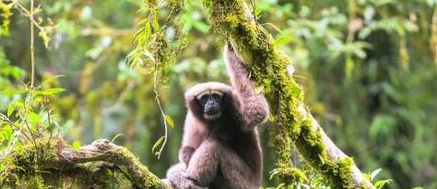(单词翻译:单击)
Scientists have discovered a new species of gibbon living in south-west China’s rainforests.
科学家在中国西南地区的热带雨林里发现了新的长臂猿品种。
Although scientists had been studying the primate for some time new research has revealed it is in fact a different species.
虽然科学家研究灵长类动物多年,但新的研究表明,这确实是一个不同的品种。
It has been named the Skywalker hoolock gibbon by its discoverers who are Star Wars fans. The name is also a nod to the fact that the Chinese characters of its scientific name Hoolock tianxing mean “Heaven’s movement”.
这个新发现的长臂猿被命名为天行者白眉长臂猿。他的发现者是电影“星球大战”的粉丝。天行的中文意思是:天堂的行动。
Dr Sam Turvey from the Zoological Society of London who was part of the team studying the apes told BBC News: “In this area so many species have declined or gone extinct because of habitat loss hunting and general human overpopulation.
来自伦敦动物学会的Sam Turvey 博士是这个研究团队的一员,他对BBC说:因为栖息地的减少、偷猎以及人口数量的过度增长,这个区域的许多物种数量都在减少或频临灭绝。
“So it’s an absolute privilege to see something as special and as rare as a gibbon in a canopy in a Chinese rainforest and especially when it turns out that the gibbons are actually a new species previously unrecognised by science.”
“所以在中国的热带雨林的树冠上看到这些既罕见又特别的长臂猿绝对是交了好运,更别说这些长臂猿还是科学家还未发现的新物种。”
The research team led by Fan Peng-Fei from Sun Yat-sen University in China first suspected that the gibbons they were studying in Gaoligongshan nature reserve in Yunnan province might be different because of subtle differences in the typical facial markings of white eyebrows and beards.
由中国中山大学范鹏飞领导的研究小组首先怀疑他们在云南省高黎贡山自然保护区研究的长臂猿可能是新物种,因为白色眉毛和胡须这些典型的面部标记有微妙差异。

Gibbons are renowned for their loud song which they use to mark territory and this also sounded unusual.
长臂猿因其善于大声鸣叫并用来标记领地而出名, 而这些长臂猿的叫声非同一般。
A full genetic and physical comparison with other gibbons then confirmed that they had found a new species.
通过与其它长臂猿完整的基因和事实比对他们证实了这是一个新物种。
The scientists estimate that about 200 Skywalker gibbons are living in China and also potentially in neighbouring Myanmar but say that the species should already be classified as endangered. Habitat loss and fragmentation is putting the gibbons at risk of extinction.
科学家们估计大约只有200只天行者长臂猿生活在中国或者他们的邻居缅甸所以他们应该已被列为濒危物种。栖息地的缺失和碎片化导致了它们有灭绝的危险。
In the Gaoligongshan nature reserve where the gibbons were discovered scientists had to trek up to 2500m to find suitable habitat as “everywhere below there has been logged” Dr Turvey said to the BBC.
在高黎贡山自然保护区里科学家们要艰难攀登上海拔2500m才到之前他们发现长臂猿的地方,“在这个高度以下森林都被砍伐了”特尔维博士对BBC谈到。


